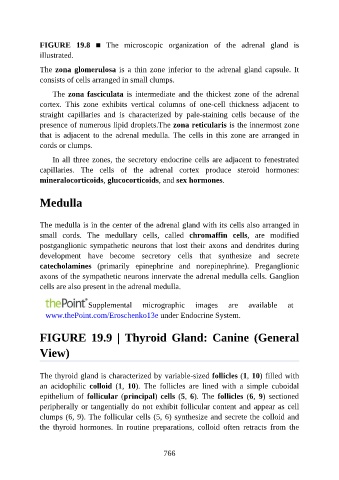Page 767 - Atlas of Histology with Functional Correlations
P. 767
FIGURE 19.8 ■ The microscopic organization of the adrenal gland is
illustrated.
The zona glomerulosa is a thin zone inferior to the adrenal gland capsule. It
consists of cells arranged in small clumps.
The zona fasciculata is intermediate and the thickest zone of the adrenal
cortex. This zone exhibits vertical columns of one-cell thickness adjacent to
straight capillaries and is characterized by pale-staining cells because of the
presence of numerous lipid droplets.The zona reticularis is the innermost zone
that is adjacent to the adrenal medulla. The cells in this zone are arranged in
cords or clumps.
In all three zones, the secretory endocrine cells are adjacent to fenestrated
capillaries. The cells of the adrenal cortex produce steroid hormones:
mineralocorticoids, glucocorticoids, and sex hormones.
Medulla
The medulla is in the center of the adrenal gland with its cells also arranged in
small cords. The medullary cells, called chromaffin cells, are modified
postganglionic sympathetic neurons that lost their axons and dendrites during
development have become secretory cells that synthesize and secrete
catecholamines (primarily epinephrine and norepinephrine). Preganglionic
axons of the sympathetic neurons innervate the adrenal medulla cells. Ganglion
cells are also present in the adrenal medulla.
Supplemental micrographic images are available at
www.thePoint.com/Eroschenko13e under Endocrine System.
FIGURE 19.9 | Thyroid Gland: Canine (General
View)
The thyroid gland is characterized by variable-sized follicles (1, 10) filled with
an acidophilic colloid (1, 10). The follicles are lined with a simple cuboidal
epithelium of follicular (principal) cells (5, 6). The follicles (6, 9) sectioned
peripherally or tangentially do not exhibit follicular content and appear as cell
clumps (6, 9). The follicular cells (5, 6) synthesize and secrete the colloid and
the thyroid hormones. In routine preparations, colloid often retracts from the
766

